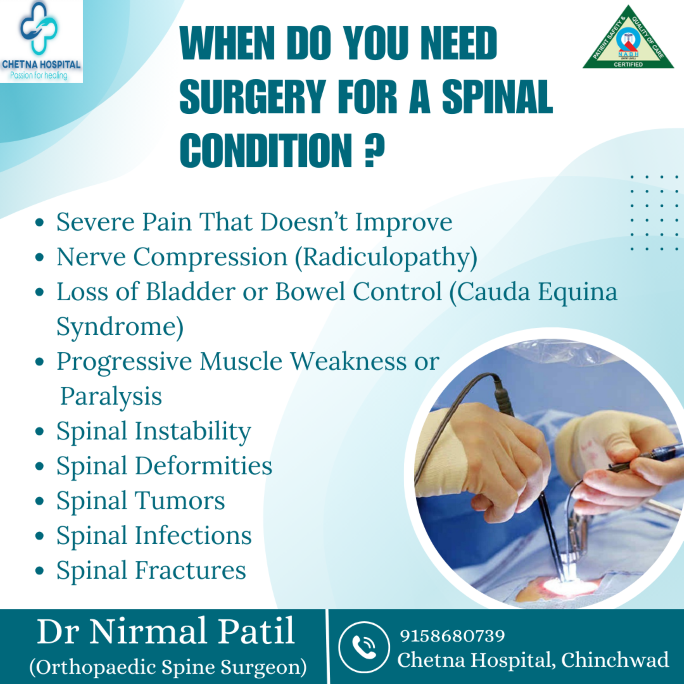Spine surgery is often a topic that evokes concern and anxiety for many individuals suffering from back pain or related conditions. While surgery is typically considered a last resort after conservative treatments have been exhausted, there are specific scenarios where surgical intervention becomes necessary. Understanding when you need spine surgery can empower you to make informed decisions about your health and well-being.
Understanding Spine Surgery
Spine surgery encompasses a variety of procedures aimed at addressing structural problems within the spinal column. These issues can range from herniated discs and spinal stenosis to fractures and deformities. The primary goals of spine surgery are to alleviate pain, restore function, and prevent further complications.
Common Reasons for Spine Surgery
- Severe and Persistent PainOne of the most common reasons individuals consider spine surgery is severe, chronic pain that does not respond to non-surgical treatments. Pain can stem from various spinal conditions, including:
- Herniated Discs: When the inner gel-like material of a disc bulges out and compresses nearby nerves, it can lead to significant pain.
- Degenerative Disc Disease: Over time, discs can lose hydration and elasticity, leading to pain and reduced mobility.
- Spinal Stenosis: Narrowing of the spinal canal can compress the spinal cord and nerves, causing pain, weakness, and numbness.
- Nerve CompressionNerve compression can cause debilitating symptoms, including radiating pain, numbness, and weakness in the arms or legs. Conditions that commonly lead to nerve compression include:
- Herniated Discs: As mentioned earlier, a herniated disc can press on spinal nerves.
- Bone Spurs: These bony growths can develop on the vertebrae and impinge on nerves.
- Spinal Stenosis: This condition can narrow the space available for nerves and the spinal cord.
- Cauda Equina SyndromeCauda equina syndrome is a rare but serious condition resulting from severe compression of the spinal nerves at the lower end of the spinal cord. Symptoms may include:
- Severe low back pain
- Numbness in the groin or saddle area
- Loss of bowel or bladder control
- Weakness in the legs
- Spinal InstabilitySpinal instability occurs when the spine is unable to maintain its normal alignment and movement. This instability can be caused by various factors, including:
- Spondylolisthesis: A condition where one vertebra slips over another, often causing pain and nerve compression.
- Traumatic Injuries: Fractures or dislocations due to accidents can compromise spinal stability.
- Severe DeformitiesSome individuals may develop severe spinal deformities, such as scoliosis (abnormal sideways curvature of the spine) or kyphosis (excessive outward curvature). These deformities can cause:
- Chronic pain
- Impaired mobility
- Breathing difficulties in severe cases
- Spinal TumorsTumors located within or around the spinal column can lead to significant pain and neurological symptoms. These tumors may be benign or malignant and can compress nerves or the spinal cord. Surgical intervention may be necessary to:
- Remove the tumor
- Alleviate pressure on the spinal structures
- Determine the nature of the tumor through biopsy
- Spinal InfectionsInfections in or around the spine can occur due to various reasons, including surgical complications, systemic infections, or direct trauma. Common infections include:
- Discitis: Infection in the spinal discs
- Osteomyelitis: Infection in the vertebrae
- Persistent Symptoms After Conservative TreatmentIf a patient has undergone conservative treatment for an extended period (typically 6-12 months) without significant improvement, it may be time to evaluate the need for surgical intervention. Symptoms such as:
- Chronic pain
- Weakness
- Functional limitations
Types of Spine Surgery
When surgical intervention is deemed necessary, various procedures may be considered based on the specific condition:
- Discectomy: Removal of the portion of a herniated disc that is pressing on a nerve.
- Laminectomy: Removal of a small section of the vertebra (the lamina) to relieve pressure on the spinal cord or nerves.
- Spinal Fusion: Fusing two or more vertebrae together to stabilize the spine.
- Vertebroplasty/Kyphoplasty: Minimally invasive procedures that involve injecting cement into fractured vertebrae to stabilize them.
- Artificial Disc Replacement: Replacing a damaged disc with an artificial one to maintain mobility and alleviate pain.
The Decision-Making Process
The decision to undergo spine surgery should not be taken lightly. It typically involves several steps:
- Consultation: Begin with a thorough consultation with a spine specialist who will evaluate your condition, review your medical history, and conduct a physical examination.
- Diagnostic Imaging: Your doctor may order imaging tests such as X-rays, MRIs, or CT scans to visualize the spine and identify any abnormalities.
- Discussion of Options: Your healthcare provider will discuss the available treatment options, including the risks and benefits of surgery compared to continued conservative treatment.
- Informed Consent: If surgery is recommended, you’ll be required to give informed consent, understanding the procedure, potential outcomes, and risks involved.
- Postoperative Care: Planning for postoperative care, rehabilitation, and follow-up appointments will be crucial to your recovery process.
Conclusion
Spine surgery is a significant decision that can lead to improved quality of life for individuals suffering from chronic pain, neurological symptoms, or debilitating conditions. It is essential to recognize the signs that may indicate the need for surgery, including persistent pain, nerve compression, and spinal instability.
If you’re experiencing any of these symptoms, consult a spine specialist to discuss your options. A thorough evaluation will help determine the best course of action for your specific condition, ensuring that your spinal health is prioritized and that you receive the most effective care possible. Remember, you are not alone in this journey—support from healthcare professionals and loved ones is vital as you navigate your path to recovery.
For Consultation Contact us on 9158680739
Website – www.chetnahospital.co.in
Address – Chetna Hospital, Sambhajinagar, MIDC, G Block, Near Rotary Club, Chinchwad 411019
.
.
.
#pune#pcmc#chinchwad#hospital#medical#medicalservices#spinesurgeon#backspecialist#sciatica#sciaticnerve#sciaticapain#sciaticatreatment#spinesurgery#spinespecialist#spinedoctor#backpaindoctor#endoscopicspinesurgery#orthopaedicsurgeon#mistlifsurgery#cervicalpain#spinalcord#rediculopathy#backpainrelief#slippeddisc#spine#neckpain#spinalstenosis#lumberlordosis#backbonesurgery













